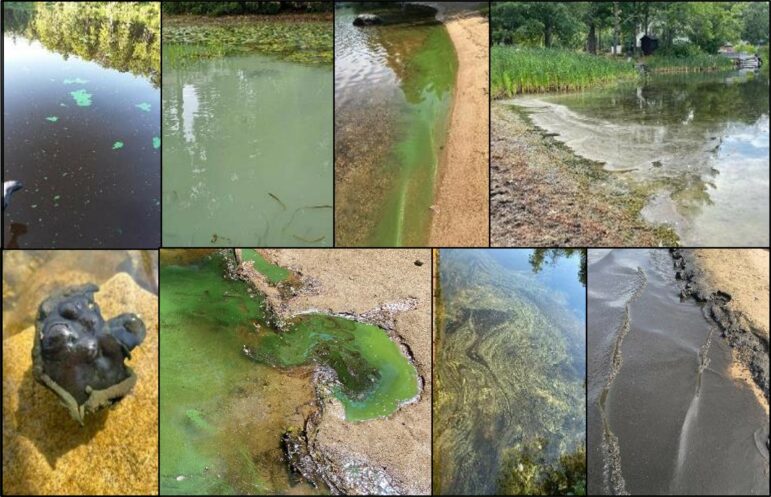
By PAULA TRACY, InDepthNH.org
LEBANON – New Hampshire has almost 1,000 lakes, ponds and water bodies which draw summer visitors from the world over to enjoy their clear, clean cool waters.
But there are increasing problems the state is seeing which not only pollute the lake but perhaps make it dangerous for humans and pets because of the neurotoxins they emit.
Cyanobacteria, also known for its appearance as blue green algae, is a naturally occurring scum which earlier this year cropped up in abundance on Lake Winnipesaukee for the first time, prompting state advisories to stay out of the water where they are seen.
While the state shows few identified problems this Fourth of July week, that can change and should be a consideration for all those who are near water bodies.
“Cyanobacteria is the biggest threat to New Hampshire that no one knows about, ” said Rosemarie Ring, D-Salem, who in 2022 with state Sen. Suzanne Prentiss, D-Lebanon, sponsored a bill to create the 17-member Cyanobacteria Plan Advisory Committee to create a report “supported by scientific data” which “shall include measurable milestones,” and a state strategy to prevent the increase and eventually control cyanobacteria blooms.
“This is a complex issue. There is growing evidence that cyanobacteria is linked to neurological diseases like ALS,” Rung said in a 2022 interview.
Rung said Salem draws its municipal drinking from Arlington Mills Pond and Canobie Lake, switching between the two. Arlington Mills Pond has had a chronic problem with cyanobacteria blooms for the past few years.
It was included in an early seasonal spate of problems in May https://indepthnh.org/2024/05/28/summer-is-off-to-a-bad-start-for-cyanobacteria-in-nh-waters/
To check on daily changes, the state has a map of alerts and warnings for cyanobacteria which can be found here.
https://www.arcgis.com/apps/dashboards/8d84a6b03acb4efaab571b222c78447b
In addition to worrying about drinking water, she is also concerned about people who rent vacation properties that have no idea that cyanobacteria blooms are becoming more frequent.
Elijah Stommel, MD, PhD, a professor of neurology at Dartmouth’s Geisel School of Medicine and a neurologist at Dartmouth-Hitchcock Medical Center has been studying the problem of cyanobacteria in New Hampshire’s lakes and the possible links to ALS (amyotrophic lateral sclerosis), or Lou Gehrig’s disease, a progressive and lethal neurodegenerative disorder affecting nerve cells in the brain and spinal cord.
As of yet, no cure has been found and no effective treatments have been developed for ALS.
He treats patients from across the region suffering from ALS and is part of an international group of scientists working to develop a cure.
They are focusing on a nerve toxin produced by cyanobacteria, BMAA and dietary exposure to it, along with L-serine, an amino acid which has been shown to block the neurotoxic effects of BMAA.
A published study showed a direct link between dietary exposure to BMAA and the development of neuropathological abnormalities.
Researchers were able to reproduce almost the same histopathology—development of brain tangles and amyloid deposits—that had been found in a group of human villagers that were studied years ago on the Pacific island of Guam. Risk of ALS there was 150 fold higher than the rest of the world.
These villagers ate cycad seeds, which contain BMAA, and many were stricken with neurodegenerative disease, suffering from symptoms that resembled aspects of Alzheimer’s disease, ALS, Parkinson’s disease, and dementia. The new study also showed that when the dietary exposure included L-serine, there was less evidence of disease.
The findings and a focus on Stommel’s study of higher than normal cluster of incidence of ALS in residents on Lake Mascoma in Enfield were included in a documentary, “The Toxic Puzzle” narrated by Harrison Ford https://www.toxicpuzzle.com/
Lake Mascoma, over the years, has had a number of detected cyanobacteria blooms and he was treating patients from the lake.
Stommel said it is a little early to tell whether BMAA may be promoting diseases like ALS, since the disease can take as long as 30 years to develop, and that was shown in Guam.
But on Lake Mascoma, where lake biologists have said the water had a history of cyanobacteria blooms, he found the chance of getting ALS was about 25 to 40 times higher than expected in the general population.
“It’s kind of alarming,” he said in the documentary. “We’ve since found 11 clusters in Northern New England, all of them have six or more cases. Almost all of those clusters are very close to water bodies that have had cyanobacteria blooms. So you can imagine living on a lake that has frequent annual cyanobacterial blooms, you might easily be exposed on a chronic basis to microorganisms that are in the air.”
While not everyone who ate the cycad seeds became ill in Guam, exposure to BMAA is probably a risk factor for those who are genetically predisposed to develop neurodegenerative disease, scientists said.
Using a number of research methodologies, they have established a statistically significant correlation between the ALS clusters (areas with an unusually high number of ALS cases) and bodies of water containing cyanobacterial blooms across northern New England.
He said breathing in the toxins can also be a factor in developing illness along with eating fish from the impacted water.
Cyanobacteria can produce toxins on the water that can pose a toxic threat to humans, pets, and wildlife, and last month, New Hampshire broke a record for the highest number of advisories ever recorded in May.
The problem seems to be growing in the Granite State and happening earlier in the summer with warmer winters. The legislature dedicated $1 million to create a mitigation loan and grant fund to deal with it and are working with the state’s many lake associations to find awareness and work on solutions to help protect the lakes.
These blooms or scum which look like paint spills in the water have increased in number due in part to a warming climate.
But it can also be that there is more awareness and thus more sightings.
Shorter winters with fewer ice-in days, the fact that surface water temperatures are increasing in the state and human-caused phosphorus introductions are factors including herbicides used for lawns and stormwater runoff from roads.
Cyanobacteria are fed by phosphorus introduced into the water and grow with warmth and sunlight. It can actually shift its height in the water column and a bloom usually lasts about three weeks.
The legislative looks at an emphasis on nutrient reduction, improved reporting, and outreach.
And in a recent visit to Lake Winnipesaukee by U.S. Sen. Jeanne Shaheen, D-NH, who is looking at the problem, was told that aging septic systems near water bodies are often a problem.
Human impacts of cyanobacteria include nausea, rash, and neurological issues but in pets and children; it can be deadly, Rung said.
Alerts are issued when there are signs that the cyanobacteria may become a problem with cell count concentrations below 70,000 counts per liter and advisories are a higher level of warning where the counts are above that threshold. Counts in 19-Mile Bay on Lake Winnipesaukee in June were found to be close to 400,000 counts per liter.
The impacts are not only to health but to the regional economy from tourism, property values, and disruption of drinking water systems.
The state is saying they are not preventing people from swimming in lakes which are posted with warnings and advisories but suggesting they and their pets stay out of the blooms themselves, but others, like Stommel, take a more cautious approach.
He said there are aerosol concerns in waters with advisories.
“If you are on a windsurfing board or you are waterskiing behind a boat you are going to get a lot of aerosol that way. If you ate fish out of a lake that has had blooms and high levels of toxins that could potentially be a source,” he said.
“If a dog eats some of the scum on the top of a pond…it will kill a dog in three or four minutes. And that happens frequently, actually. Domestic animals do drink the water and can get very sick or die,” Stommel said.
There may be half a dozen or more toxins that cyanobacteria are making, he said, all of which have a different target on the central nervous system and when they work together synergistically they might be much more toxic than being exposed to just one of them, individually, Stommel said.
“And of course there are other things in the environment that are neurotoxic and might contribute to diseases like Parkinsons and ALS and that would include exposure to pesticides, heavy metals, air pollution, dioxins, even things like PFAS which are contained in a lot of products we buy in stores and an important ingredient the foam that is sprayed out of airplanes to put out forest fires. And you can imagine the amount of these forever chemicals that are sitting in the groundwater now because of being dumped out of airplanes to get rid of forest fires which are probably being fueled by global warming to a certain extent. So it is a very vicious cycle.”
He urged residents and visitors to exercise caution and be alert to the signs.
Stommel said he is not a limnologist (a lake biologist) and he should keep his mouth shut but asked are they checking the water everywhere? Are they just checking where the blooms are? Can you miss a bloom? Yes. They might be right under the surface of the water…so you could easily miss one,” Stommel said.
“I’d be careful. I’d be very careful,” he said.
Irritation of the skin might be something to pay attention to, he said. Also, you could have GI upset from exposure.
He said he received “a lot of pushback from the State of Vermont” when he tried to present research findings around Lake Champlain which has had a problem.
“There is a legitimate concern for tourism. A lot of people depend on it,” Stommel said, noting property values as well could suffer.
But frankly, he said, it would be hard to rent a cottage on a water body that has scum in front of it and smells bad.
He said he is not suggesting authorities are sweeping it under the rug but trying to deal with the actual underlying reason why the blooms are occurring is really important.
“I can’t tell you why they have suddenly become more prevalent in Lake Winnipesaukee but certainly there have been water bodies in that area that have been affected in the past. It is not a new phenomenon.”
Currently an advisory has been issued for Lake Kanasatka in Moultonborough which flows into Lake Winnipesaukee.
On June 21, there were cyanobacteria advisories posted in Wolfeboro, Tuftonboro, Center Harbor, Meredith Bay and in the Broads off the shores of Governor’s Island in Gilford in addition to other water bodies in New Hampshire.
To get alerts for specific water bodies in the state, you can sign up for information here https://lp.constantcontactpages.com/su/pHPCXq8/healthyswimming
InDepthNH.org will be focusing on the subject of cyanobacteria and the health of New Hampshire lakes this summer and story ideas on the subject and comments are welcome at paulatracy6@gmail.com

Paula Tracy has been a reporter in New Hampshire since 1982. Last year the New Hampshire Press Association honored her with a lifetime achievement award and this year she took first place in our division for her Investigative Reporting.





